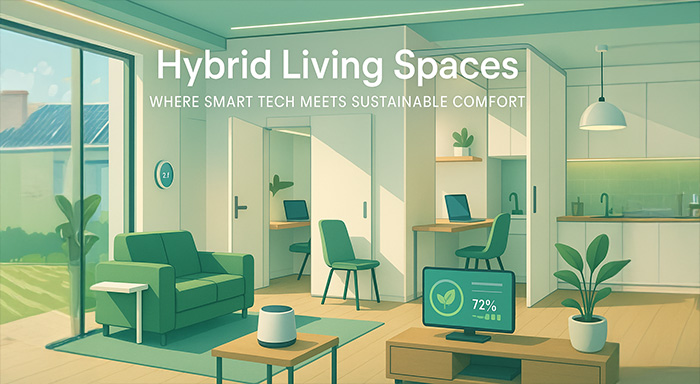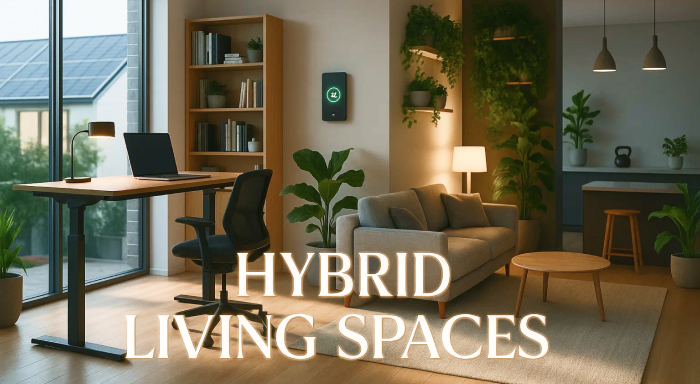Changing lifestyles and remote work culture have led to people demanding more from their living spaces and made it difficult to find the perfect home. Nowadays, a home isn’t just a place to sleep; it has evolved into being a comfortable environment that can handle jobs, hobbies, and even small businesses. The challenge that real estate faces in 2025 is that most traditional properties don’t meet these needs. The solution: hybrid living spaces that are reshaping the real estate industry. These homes are a blend of work-friendly features with sustainable designs to provide a space that is comfortable as well as functional. In this blog, we have discussed about the hybrid living spaces, their key benefits, and how they’re redefining the housing market. Ready to rethink what a home can do? Keep reading!
Defining Hybrid Living Spaces
Hybrid living spaces blend residential properties with features often found in commercial spaces. These homes adjust to modern needs by combining work and leisure within the same environment. They also offer versatile layouts that addresses the requirements of remote work and adaptable lifestyles. “Home offices are no longer a luxury; they’re a necessity,” said real estate expert Jana Collins. Implementation of this concept involves smart homes equipped with AI-driven home automation and energy-saving appliances. Hybrid properties might also have adaptable room configurations for owners to effortlessly switch between professional and personal use.
Factors for the Popularity of Hybrid Living Spaces

In 2025, people want homes that can acclimate to their evolving needs. This shift in lifestyle has changed our perception towards living spaces.
Preferential Shift Towards Remote Work
After the global pandemic, businesses adopted hybrid work models supported by evolving technology. Residential properties transformed into hubs that fuse professional and personal spaces. Demand for traditional office settings reduced as more companies embraced a flexible approach. This shift created immense pressure on real estate to modify. High-speed internet, AI-powered home automation, and advanced security systems are no longer a luxury; they have become standard features in homes. People seek properties that have a specific office space or customizable rooms designed to be productive. Suburban growth fuelled by remote work enabled buyers to explore low-cost housing options with more space. Demand for versatile homes is now shaping design trends dramatically.
Demand for Multi-Functional Homes
Homebuyers now prioritize spaces that serve several purposes. A living room might also function as a home office, gym, or even a classroom. Hybrid homes cater to the needs of remote work and virtual learning while maintaining comfort. Both professionals and growing families prefer rooms with adjustable layouts. For instance, collapsible walls or modular furniture can reconfigure spaces instantly. These designs align with the active lifestyles without the need for scalability in residential properties.
Emerging Sustainable Lifestyle Trends
Energy-saving designs are incorporated into hybrid homes to reduce waste and lower utility costs. Modern residential properties are getting equipped with solar panels, rainwater harvesting systems, and energy-efficient appliances. These features are appealing to environmentally conscious buyers while decreasing expenses. Green living is no longer just a trend; it has become the future of real estate. With its focus on multi-purpose projects, urban planning now incorporates sustainable transport options like bike lanes and electric vehicle chargers. This transition corresponds with rising demand for houses in eco-friendly neighbourhoods, enabling businesses to attract clients while complying with their sustainability goals.
Key Features of Hybrid Living Spaces
Hybrid living spaces excel through versatility by combining comfort with tech-savvy designs to simplify daily life.
Smart Home Technology
Smart home technology elevates convenience and efficiency through AI-powered home automation systems that can control lighting, temperature, and appliances with simple voice commands or mobile apps. To get an understanding about how these smart systems can support remote operations and cybersecurity needs in residential tech setups, visit cloudsecuretech.com.
Holistic security systems enable homeowners to maintain safety with real-time surveillance, smart locks, and motion detection. Connecting energy-efficient appliances to these networks reduces utility bills while promoting sustainable living practices. Homeowners can track daily usage with features like automated energy monitoring to make eco-friendly decisions. Businesses that invest in residetial properties observed an increase in the demand for tech-savy homes as buyers prefer modern functionality.
Energy Conservative Designs
Smart technology seamlessly aligns with energy-efficient designs. Today, modern hybrid homes consist of solar panels, advanced insulation, and energy-efficient appliances. AI-powered systems automatically adjust lighting and temperature based on occupant patterns. These updates support a sustainable lifestyle while minimizing carbon footprints. Business owners can take advantage of this demand by investing in properties designed for low-energy consumption. New buyers look for homes with the dual benefits of comfort and reduced operational expenses. Green certifications like LEED contribute to the the appeal of residential properties and attract eco-friendly investors. Builders with a focus on sustainable development, such as those known for JayMarc’s quality craftsmanship, are revolutionising hybrid living spaces by blending elegance with energy efficiency.
Flexible Room Configurations
Rooms now serve multiple purposes. A home office turns into a guest room by adding a foldable desk and a Murphy bed. Sliding walls or modular furniture systems make the most of small spaces without compromising comfort. Properties with adjustable layouts should be the priority for businesses investing in real estate. Remote workers seeking flexibility prefer these homes, enhancing property value potential over longer period.
Real Estate Market Trends: Backed by Hybrid Living Spaces
Hybrid living spaces are transforming the way people decide to settle which has opened new prospects for both developers and buyers.
Expansion in Suburban and Secondary Markets
There has been a spike in housing demands in small towns and suburban areas due to remote work eliminating the need for people to live near their offices. This has encouraged families and professionals to look for quieter neighbourhoods. Compared to the over-populated urban hubs, these areas offer larger residential properties at lower costs. Real estate trends showcase a shift in focus towards secondary markets for new property expansion. Suburban growth opens new avenues for businesses away from the expensive city lifestyle. Multi-functional developments that offer retail spaces near homes are gaining popularity as they enable convenience and reduced travel time for residents.
Rising Interest in Mixed-Purpose Projects
There has been a notable rise in mixed-purpose projects in cities and suburbs. These projects integrate residences, commercial units, and recreational zones into one living environment. Business owners benefit from the consistent traffic from nearby residents. Restaurants, retail stores, and offices thrive in these centres due to convenience-focused customers. Hybrid homes integrate well within such projects by catering to people seeking both work-from-home setups and recreational amenities close by. This combination creates lively communities where housing demand aligns with modern lifestyle needs. The concept of co-living and shared spaces gaining interest further influences this trend.
Increasing Demand for Co-Living and Shared Spaces
Urban professionals and young renters are widely preferring co-living spaces. These arrangements are a cost-effective solution that offer shared amenities like kitchens, lounges, and workspaces. Housing projects that balance privacy with community living are preferred by many. Catering to this demand, hybrid homes often include such layouts. Multi-purpose projects also boost this trend as they combine residential properties with commercial spaces. Nearby shops, cafes, or gyms are accessible to the tenants, eliminating long commutes. Such properties offer consistent occupancy rates and reduce vacancy risks which is beneficial for businesses investing in them.
Benefits of Hybrid Living Spaces for Homeowners
Hybrid homes make daily life easier by combining comfort and practicality. They also accommodate evolving lifestyles without exceeding the budget.
Enhanced Work-Life Balance
Workers have adapted to remote work, transforming homes into both offices and relaxation spaces. Hybrid living spaces acknowledge this by incorporating quiet zones as well as open designs. Adjustable room configurations enable effortless transition between tasks and leisure. Peaceful environments in suburban areas encourage healthy habits while reducing the stress borne out of city life. Energy-efficient appliances also save time and efforts that can be diverted towards family or hobbies. The expanding market for economical investments has also generated interest in multi-functional spaces.
Economical and Multi-Functional Investments
Hybrid living spaces combine the functionalities of residential and commercial units. A single property can be used as a home, office, or even a rental unit. This adaptability removes the need for maintaining separate properties, reducing expenses. Property investors and owners also benefit from the rising housing demand for flexible designs. Remote workers and small business owners find features like adjustable configurations and unified security systems appealing. There is a rise in the long-term value potential of these properties in the real estate market.
Enhanced Sustainability to Reduce Carbon Footprint
Energy-efficient appliances like smart thermostats, LED lightings, and automated cooling systems in hybrid homes reduce electricity usage and minimize energy waste. Implementing these practices can cut expenses for businesses while supporting environmental objectives. Mixed-use developments encourage shorter commutes, reducing traffic congestion. Suburban growth with integrated living spaces helps control urban expansion and decreases construction's environmental impact. These strategies create sustainable housing solutions that benefit both businesses and communities alike.
Challenges in Adopting Hybrid Living Spaces
Finding the right balance between affordability and functionality leaves many potential buyers puzzled—curious to know why? Let us tell you.
Economic Accessibility and Supply Limitations
Affordability for hybrid homes has been constrained due to rising demand. High-demand suburban development areas offer limited availability for residential properties, making it worse. Builders frequently experience supply chain delays which increase the cost of materials like steel and lumber. Zoning laws further add to the difficulty as traditional floor plans are preferred by most urban planning regulations. The approval process gets slowed down integrated living spaces or multi-purpose projects. Lack of sufficient inventory to meet the scalability needs lead to rising prices. As a result, potential buyers are left waiting or unable to afford homes.
Zoning and Regulatory Barriers
Strict zoning laws and outdated regulatory frameworks often hinder the development of hybrid homes. Many local governments impose rigid limitations on mixed-use developments, making it difficult to combine residential properties with commercial spaces. These restrictions slow down housing demand solutions and hinder growth in suburban markets. Bureaucratic hurdles can delay the approval processes for mixed-purpose homes. This acts as a setback for projects that plan to incorporate energy-efficient appliances or AI-driven home automation systems into modern designs. Removing these obstacles could be beneficial for property developments that align with future living spaces.
Future Trends: Real Estate with Hybrid Living Spaces
Hybrid living spaces will bridge the gap between tech, comfort, and sustainability like never before.
Hybrid Home Designing: Technological Importance
Hybrid homes offer AI-powered automation systems that add to the ease of doing daily tasks. Intelligent temperature controls, combined security systems, and energy-efficient appliances create comfortable and sustainable spaces. Virtual staging tools assist developers in visualizing layouts, saving time during the design process. Advanced software supports architects in designing adaptable room configurations for work and relaxation. Property owners can rely on apps to monitor energy consumption or adjust lighting remotely. These technologies improve functionality while lowering carbon footprints in residential properties.
Evolving Preferences of Homebuyers and Investors
The shift toward hybrid homes reflects changing priorities among buyers and investors. Many now focus on multi-purpose spaces that support both remote work and daily living needs. Features such as adaptable room designs, built-in security systems, and energy-efficient appliances rank higher on wish lists. Investors pay greater attention to suburban growth and mixed-use developments due to rising demand for alternative living spaces. Young buyers looking for affordable options prefer co-living areas with shared amenities. With sustainability gaining importance, projects designed to reduce environmental impact are gaining popularity in the real estate market.
Conclusion
Hybrid living spaces combine comfort, functionality, and sustainability which has redefined our living and working culture. In 2025, as the demand for smarter and greener homes rise, real estate trends are experiencing a significant moment. More than just homes, these spaces are the future where life adapts. Homeowners and investors need to take proactive measures to keep up with the changing pace.


